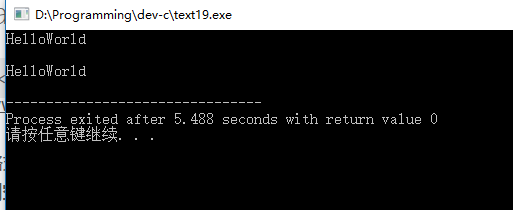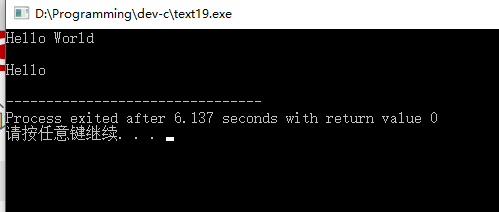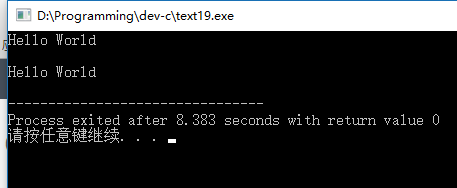C语言-scanf处理多个空格的字符串
中山大学数据科学与计算机学院
目录
1. Scanf的基本用法
int scanf ( const char * format, ... );首先让我们来了解一下scanf函数的基本用法。
scanf是C语言标准输入流(stdio)里面提供的一个输入数据的函数,对于不同的数据类型可以用用不同的格式来读取,然后储存在变量之中。
下表是各种数据类型用scanf时的标识
specifier Description Characters extracted i Integer Any number of digits, optionally preceded by a sign (+ or -).Decimal digits assumed by default (0-9), but a 0 prefix introduces octal digits (0-7), and 0x hexadecimal digits (0-f).Signed argument. d or u Decimal integer Any number of decimal digits (0-9), optionally preceded by a sign (+ or -).d is for a signed argument, and u for an unsigned. o Octal integer Any number of octal digits (0-7), optionally preceded by a sign (+ or -).Unsigned argument. x Hexadecimal integer Any number of hexadecimal digits (0-9, a-f, A-F), optionally preceded by 0x or 0X, and all optionally preceded by a sign (+ or -).Unsigned argument. f, e, g ,a Floating point number A series of decimal digits, optionally containing a decimal point, optionally preceeded by a sign (+ or -) and optionally followed by the e or E character and a decimal integer (or some of the other sequences supported by strtod).Implementations complying with C99 also support hexadecimal floating-point format when preceded by 0x or 0X. c Character The next character. If a width other than 1 is specified, the function reads exactly width characters and stores them in the successive locations of the array passed as argument. No null character is appended at the end. s String of characters Any number of non-whitespace characters, stopping at the first whitespace character found. A terminating null character is automatically added at the end of the stored sequence. p Pointer address A sequence of characters representing a pointer. The particular format used depends on the system and library implementation, but it is the same as the one used to format %p in fprintf. [characters] Scanset Any number of the characters specified between the brackets.A dash (-) that is not the first character may produce non-portable behavior in some library implementations. [^characters] Negated scanset Any number of characters none of them specified as characters between the brackets. n Count No input is consumed.The number of characters read so far from stdin is stored in the pointed location. % % A % followed by another % matches a single %.
用上表的各种格式可以输入各种数据格式到程序中进行处理
但是,在遇到空格的时候,scanf明显遇到了问题
2. 输入带有空格的字符串
#include <stdio.h>
int main()
{
char str[1000];
scanf("%s",&str);
printf("\n%s\n",str);
return 0;
} 运行上述一段代码,输入HelloWorld,我们会得到这样一个结果:
这一次,我们来输入Hello World,会是怎么样的呢?
这是为什么呢?
原来,在
scanf("%s",&str);中,scanf函数遇到 TAB
⋃
空格
⋃
\n 的时候视为输入结束。
那么,难道scanf就不可以用来输入带有空格的字符串吗?1答案当然是否定的,我们可以改一下数据类型,像下面这样:
scanf( "%[^\n]",str);修改代码后,重新执行一次看看:
完美运行!
这是为什么呢?
其实 %[^\n] 的意思就是“遇到换行才结束”,那样,在我们输入空格的时候,scanf就不用自动终止读取了,直到我们按下回车换行。
同样的道理%[^ ] 的意思就是“遇到空格就结束”,那样和我们一开始的程序的功能是一模一样的,以此类推,我们可以得到scanf函数的扩展,利用这个功能,我们可以对字符串进行更快捷更方便的处理啦!O(∩_∩)O
3.处理未知数量的多个数据
当我们要用scanf输入一大串,不知道多少的字符的时候,就要用到EOF文件末2
代码如下:
int a = 0, sum = 0;
while (scanf("%d", &a) != EOF) {
sum += a;//这里可以把数据存入数组,方便接下来的处理
}这里运用到了While循环语句,一直读取输入字符串,以遇到 TAB
⋃
空格
⋃
\n 的时候视为输入一个数据结束,然后一直输入数据,直到读取到EOF文件末。
当然还有其他的方法,就是利用<string.h>里面的strtok函数3,缺点就是异常复杂,但是优点就是可以用各种字符来分割输入的字符串
#include<stdio.h>
#include<string.h>
#include <stdlib.h>
int main(){
char num[100000];//定义字符串
int temp;//临时储存变量,也可以换成char类型
//gets(num);
scanf( "%[^\n]", num );//忽略空格停止,一直扫描字符串至换行
char* token = strtok(num, " ");//这里是以空格作为分割符
temp=atoi(token);
while( token != NULL )
{
temp=atoi(token);
//这里可以对 进行处理
//也可以传进数组里
token = strtok( NULL, " ");
}
return 0;
}
总结
通过多种示例,我们了解到了scanf函数对多个空格的字符串的多种处理方法,也加深了我对这一函数的认识
感谢阅读,初次写博客错误在所难免,如有不当之处,希望得到大家的指正,谢谢!
- 我们还可以利用其它的函数来读取,比如,用gets()读取字符串,遇\n结束,会把\n读取,转换为\0,输入流中不再有\n。
参考:http://www.cplusplus.com/reference/cstdio/gets/ ↩ - Scanf and EOF (End Of F文件末)自己在本地测试时,也能输入EOF。Windows中,先输入数据回车,按下
Ctrl+Z,命令行里出现^z,回车,就会写入EOF。Linux中,先输入数据再回车,按下Ctrl+d,就会写入EOF。 ↩ - strtok
定义函数:char * strtok(char *s, const char *delim);
函数说明:strtok()用来将字符串分割成一个个片段。参数s 指向欲分割的字符串,参数delim 则为分割字符串,当strtok()在参数s 的字符串中发现到参数delim 的分割字符时则会将该字符改为\0 字符。在第一次调用时,strtok()必需给予参数s 字符串,往后的调用则将参数s 设置成NULL。每次调用成功则返回下一个分割后的字符串指针。
返回值:返回下一个分割后的字符串指针,如果已无从分割则返回NULL。
参考:http://www.cplusplus.com/reference/cstring/strtok/ ↩

























 1099
1099

 被折叠的 条评论
为什么被折叠?
被折叠的 条评论
为什么被折叠?








